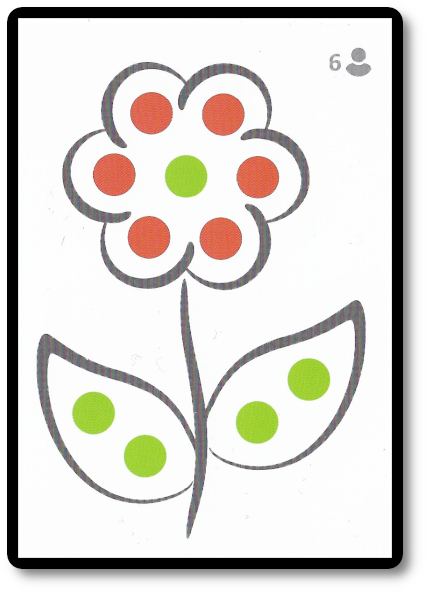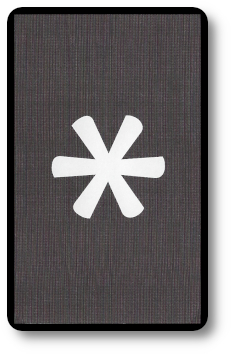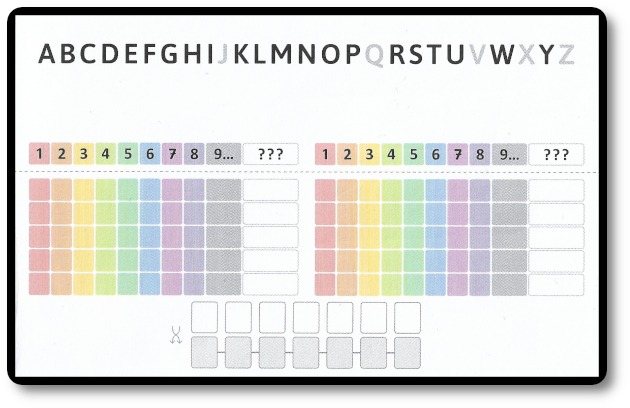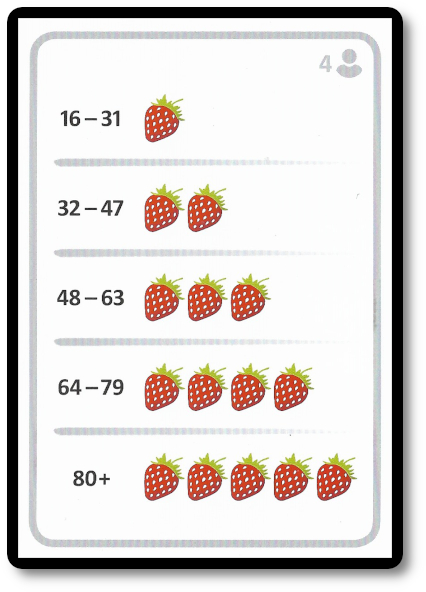
The Basics:
- For ages 10 and up
- For 2 to 6 players
- Approximately 45 minutes to complete
Geek Skills:
- Active Listening & Communication
- Logical & Critical Decision Making
- Reading
- Cooperative & Team Play
Learning Curve:
- Child – Easy
- Adult – Easy
Theme & Narrative:
- Work together to solve your hidden word puzzle
Endorsements:
- Gamer Geek approved!
- Parent Geek approved!
- Child Geek approved!
Overview
English novelist and essayist, journalist and critic, George Orwell (whose real name is Eric Arthur Blair – fun fact), said: “Language ought to be the joint creation of poets and manual workers.” In this game, players will work together to put together a series of clues – both seen and unseen – to help each player solve their word puzzle. It’s a game that takes communication and teamwork, guessing and deduction, and, most importantly, is specific to each player’s vocabulary skills!
Letter Jam, designed by Ondra Skoupý and published by Czech Game Edition, is comprised of 64 Letter cards, one Wild card, four Setup cards, eight Number tokens, six pencils, six card stands, six red Clue tokens, nine green Clue tokens, and one pad of Guessing sheets. Also included, although not noted as part of the game components, is a small pencil sharpener. I LOVE THIS as it demonstrates that the good folks at Czech Game Edition are putting some serious thought into what they put into their game boxes. All the game components are solid and durable, which is what I have come to expect from this company.
Pump Up the (Letter) Jam
To set up the game, first place the Number tokens, the Setup card (with the face-up side matching the number of players), and the Wildcard in the middle of the playing area. Place the red and green Clue tokens on the Setup card, matching color to token on the image shown on the Setup card.

The card used for a six-player game
Second, shuffle the Letter cards and divide the deck as evenly as you like, but don’t put a lot of effort into it.
Third, each player looks through their deck of cards and picks five cards to spell a five-letter word (by default). You can make the game easier or more difficult by deciding – as a group – how many letters should be used by all or for an individual. For example, if you are playing with younger players, make words that use three letters. If you are playing at a table primarily comprised of Oxford professors, try seven letters. When the cards are selected, shuffle and pass them to the player on the right. When cards are acquired, place them in a row in any order you like as long as you do not look at the face of the cards.
Note: Any word will do when deciding what cards to use, but the goal is to select a word that the player you are passing the cards to will know. For example, if I were passing cards to my mom, I would choose the word “doggy” because she loves dogs. I would not select “canis,” as she doesn’t speak a dead language. If you were to play with me, the following would be a great choice.

Fourth, collect the Letter cards not used, shuffle, and place face-down to create the Letter draw deck.
Fifth, give each player a card stand. Being careful not to see the Letter card, each player takes the Letter card on the left-most end of their row of their face-down Letter cards and places it in the card stand, ensuring the card is now facing the other players. Super crucial that everyone but the player who owns the card sees the Letter card’s value.
Sixth, regardless of the number of players in the game, all card stands will be used. These are referred to as “non-player stands.” Several Letter cards are drawn and placed in a stack behind the non-player stand (as indicated by the Setup card). Underneath the stack, place one green Clue token. Draw the top-most Letter card from the non-player stand and place it in the non-player stand cardholder.
That’s it for the game setup. Determine who will go first, give each player a pencil and Guessin sheet, and begin.
Gu?ss?ng Wo*ds
Letter Jam is played in rounds and turns with a total number of rounds equal to the number of cards in each player’s word. At the start of the game, each player can see the first letter of each of the other players except their own. Don’t worry about that because all the players in the game are working together! A game round is structured into several phases, as summarized here.
Phase One: Make a Word
Each player looks at the Letter cards in front of them and attempts to make a word out of the letters shown. You can only use the letters you see, but you are welcome to use letters multiple times and in any order. You are not required to use all the visible letters. For example, if a player sees the letters “P,” “A,” “S,” and “T.” They could write the word “ASP,” “PASS,” “TAP,” “SAT,” or “PAST.”
There is one exception to the rule when making a word. If you want to, the Wildcard can be used to represent any letter. This is helpful when making up a word when all the Letter cards in front of you are consonants, but be careful. Since a Wildcard can be any letter, it doesn’t help in pinpointing specific Letter cards in play. In short, use the Wildcard wisely. It’s there to fill in gaps but can also create a few holes. Make sense? Sure it does, and I’ve now labored the point.

Phase Two: Select the Clue Giver
All the players now decide who among them will be the “Clue Giver” for the round. This is done by each player discussing what clues they could give without actually giving anything away. They answer questions like how many letters they have in their word, how many players their clue would help, and so on. Players do not say anything about any player specifically, nor do they say anything at all about the letters on the cards in front of them.
After all the players have given what little information they can, they collectively select one player among them to be the Clue Giver. It’s important to note that this is not a popularity contest, nor does it bring any value to the game if a player overembellishes the value of their clue. Since all the players are working together, it’s in everyone’s best interest, to be honest about what you can or cannot provide.
Phase Three: Clues and Tokens
The Clue Giver now collects a Clue token. The Clue tokens indicate the number of clues that can be given during the game. If the player has never given a clue before, they take a red Clue token. If they have a red Clue token already, they take a green Clue token. There is no limit to the number of green Clue tokens a player can have.
Depending on the Setup card used, there will be one or three green Clue tokens surrounded by red Clue tokens. These green Clue tokens cannot be taken until the red Clue tokens have been claimed. This encourages all players in the game to be the Clue Giver at least once.
But there is another reason why players should be interested in the Clue tokens. Once all the Clue tokens are taken, the game comes to an end. Players can get a bonus round by using all the Letter cards owned by the non-players, moving the uncovered green Clue token to the Setup card.
Phase Four: Spell Out the Word
The Glue Giver now takes the Number tokens and places them in the sequential order in which they appear in the word they are using as part of their clue. For example, if I made the word “CAT,” I would place the “1” Number token by the “C,” the “2” Number token by the “A,” and the “3” Number token by the “T.” If using the Wildcard, place the Number token by it when it’s used. The same goes for the non-player Letter cards.
Phase Five: Write Down the Word
Each player now takes their pencil and Guessing sheet and writes down the word they think is being spelled out. Each column has a number. These numbers correspond to the Number token. Place a “?” in the column for the Letter card you cannot see (that is the player’s Letter card) and an “*” in the column to represent the Wildcard.

If the player believes they know what their Letter card is, they enter it into the white card box at the bottom of the sheet that represents the Letter card’s current position. This “locks” the letter in that position. However, if the player does not know, they can venture a guess by putting the letters they think it is in the “???” box found in that row.
At the top of the Guessing sheet is the alphabet. Some of the letters are greyed out. This indicates that the letter shown is not available as a Letter card. The Wildcard can only represent these letters!
Phase Six: Cleanup and Next Round
This ends the round. If any of the non-player cards were used, they are now discarded, and the next Letter card is drawn from the stack. Place the drawn Letter card in the cardholder. If the last Letter card is drawn and reveals a Clue token, move the Clue token to the Setup card. Bonus clue!!!
Each player now places their Letter card face-down, removes the card stand, takes the next Letter card in the row (from left to right), and adds it to the card stand, revealing it to all the other players except themselves. The next round can now begin!
Players can have words of different lengths. If a player runs out of letters (for example, players are on round four, but the player only has three Letter cards), they draw a Letter card from the Letter draw deck, adding it to their card stand. If the player’s “Bonus” Letter card is used during the subsequent rounds, they write down what they think the word is and then get to tell the other players. If the player guesses right, their Letter card is placed face-up next to the Setup card. If they guessed wrong, there is no penalty. Bonus Letter cards can be used during subsequent rounds to help spell words, but are considered a different group. This means when giving clues the player should say, “I spelled a word using the bonus letter and two letters owned by the players.” Important information!
If a Bonus letter is used during Phase Four, it is removed and discarded when the Number token is taken off of it.
All Jammed Up
The game can end in two different ways. The first is when the last Clue token is taken from the Setup card. The round ends, and the game ends, as well. The second is when all the players agree to end the game because all of their Letter cards have been used.
All players now look at their Guessing sheets and attempt to determine what their word is. Remember, the word you are trying to spell with the letters you think you selected correctly is meant to be a word you recognize. If the chosen letters don’t make a word, players are welcome to go back through their Guessing sheet to see what clues were given. The player then writes the word they are guessing in the grey boxes. The player then moves the Letter cards in front of them, rearranging the order of the Letter cards to spell the word they wrote in the grey boxes. Make sure not to look at the Letter cards when doing so!
Bonus cards and the Wildcard can be taken by a player to represent the letter under that card if they like, but each card can only be used once. You can also use the Number tokens to help identify and then arrange the Letter cards into the correct sequence.
Now each player reveals the Letter cards in front of them. If the Letter cards spell a word, any word, regardless if it the word intended or not, the players did great! If all the players spelled a word, everyone at the table wins! The Scorecard can be used to provide a point value if players want to. It allows players to determine how great of a victory they had using points to represent the achievement level. Wherein one strawberry is “edible,” and five strawberries are “Super Sweet.”

To learn more about Letter Jam, visit the game’s webpage.
Final Word
 The Child Geeks enjoyed the game, mostly because it was a cooperative experience. According to one Child Geek, “What I like about this game the most is that we are all working together. I never felt like I didn’t know enough or was dumb. My friends helped me, and I helped them.” Another Child Geek said, “I don’t like spelling games. This one was different because you had to be a detective and speak in code with your friends who did the same with you.” And by “speaking in code,” the Child Geek is referencing how players must determine the Clue Giver for each round. When all the votes were in, the Child Geeks gave Letter Jam their full endorsement.
The Child Geeks enjoyed the game, mostly because it was a cooperative experience. According to one Child Geek, “What I like about this game the most is that we are all working together. I never felt like I didn’t know enough or was dumb. My friends helped me, and I helped them.” Another Child Geek said, “I don’t like spelling games. This one was different because you had to be a detective and speak in code with your friends who did the same with you.” And by “speaking in code,” the Child Geek is referencing how players must determine the Clue Giver for each round. When all the votes were in, the Child Geeks gave Letter Jam their full endorsement.
 The Parent Geeks, having played spelling and Word games before, had no problem jumping in and taking over. What they found to be the most surprising was how difficult it was at times to guess the word. According to one Parent Geek, “I know the word in front of me using the Letter cards – once properly arranged – will spell a word that I know. You’d think that would be enough for me to work out the word quickly, but not a chance. I love the challenge of knowing you know, but I also don’t know a thing.” Another Parent Geek said, “A great game that requires communication, deduction, and cooperation. I enjoyed it a great deal and loved that my kids could play it, too, without having the dumb the game down.” When all the letters were correctly arranged, they spelled “WIN” by the Parent Geeks, who fully endorsed the game.
The Parent Geeks, having played spelling and Word games before, had no problem jumping in and taking over. What they found to be the most surprising was how difficult it was at times to guess the word. According to one Parent Geek, “I know the word in front of me using the Letter cards – once properly arranged – will spell a word that I know. You’d think that would be enough for me to work out the word quickly, but not a chance. I love the challenge of knowing you know, but I also don’t know a thing.” Another Parent Geek said, “A great game that requires communication, deduction, and cooperation. I enjoyed it a great deal and loved that my kids could play it, too, without having the dumb the game down.” When all the letters were correctly arranged, they spelled “WIN” by the Parent Geeks, who fully endorsed the game.
 The Gamer Geeks were skeptical, but they found Letter Jam to be a brain teaser and a challenge worth leaning into. According to one Gamer Geek, “I am not a fan of Word games. Hate Scrabble and I’ll be the first to burn any copy of Bananagrams I come across. This game, however, mellowed me down considerably. I was challenged, laughed, had fun, and enjoyed myself. I still don’t like Word games, but this I would play again.” Another Gamer Geek said, “A good mix of deduction and cooperative gameplay. I don’t think I’ve ever played anything like it, and that says something. Good stuff here, and I think I might even play this with my family.” When all the votes were in, the Gamer Geeks approved Letter Jam, welcoming it back to their elitist gaming table.
The Gamer Geeks were skeptical, but they found Letter Jam to be a brain teaser and a challenge worth leaning into. According to one Gamer Geek, “I am not a fan of Word games. Hate Scrabble and I’ll be the first to burn any copy of Bananagrams I come across. This game, however, mellowed me down considerably. I was challenged, laughed, had fun, and enjoyed myself. I still don’t like Word games, but this I would play again.” Another Gamer Geek said, “A good mix of deduction and cooperative gameplay. I don’t think I’ve ever played anything like it, and that says something. Good stuff here, and I think I might even play this with my family.” When all the votes were in, the Gamer Geeks approved Letter Jam, welcoming it back to their elitist gaming table.
 I would like to preface my thoughts on the game by first stating that Word games are not my forté. I have never found Word games to be engaging or particularly entertaining. This is primarily based on my observation that Word games leverage a player’s vocabulary and spelling skills. This is a skill set that is much dependent on age and education, which doesn’t make for a level playing field when attempting the game at the family gaming table.
I would like to preface my thoughts on the game by first stating that Word games are not my forté. I have never found Word games to be engaging or particularly entertaining. This is primarily based on my observation that Word games leverage a player’s vocabulary and spelling skills. This is a skill set that is much dependent on age and education, which doesn’t make for a level playing field when attempting the game at the family gaming table.
That being said, Letter Jam not only amusing but was a game that could be played with others regardless of their language skills. This is due to the game’s cooperative gameplay, and how the word each player is guessing is purposely selected to be something that the player knows. I would have thought that this would make the game more relaxed, but at no time did I ever feel that that the players had an easy road to travel. There is enough information in the game to always give you a good idea, but never enough to make it visible. Not until the end, that is, but even that is still an exercise in working through your guesses.
A word of caution here for those of you who decide to purchase and teach this game. The rule book is not an easy one. Everything is spelled out for you (no pun intended), but the rule book goes into great detail about what the game is about without giving you a lot of context of how the game uses the rules. I suggest you teach yourself how to play first with the game components. It all makes sense once you see it in action in front of you. The rules, if read, make the gameplay unintuitive. Put the game in front of you with the rules and – BOOM! – instant connecting of the proverbial dots.
Letter Jam is a solid game for a mixed group who are looking for a cooperative experience. The gameplay and deduction are deep enough to keep gaming elitists involved, and the sliding personal difficulty scale with cooperative gameplay makes it accessible to anyone. You can mix and match your groups of players from different ages and skill levels and not once have a game that feels unbalanced. Do try this Word game when time allows and see if it spells out “fun” for you and yours.
This game was given to Father Geek as a review copy. Father Geek was not paid, bribed, wined, dined, or threatened in vain hopes of influencing this review. Such is the statuesque and legendary integrity of Father Geek.



